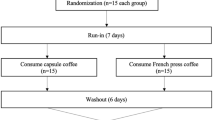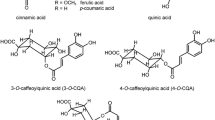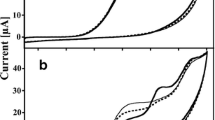Abstract
The effect of new coffee brewing, coffee capsules, on the antioxidant activity (ORAC and ABTS), total phenolic content, chlorogenic acid, caffeine, and melanoidin concentration was assessed and compared with the conventional coffeemakers (filter, mocha, and expresso). In addition, the aluminum content was also analyzed to investigate the potential migration of this metal from the capsule to the beverages. The capsule method showed the lowest values of antioxidant capacity and total phenolic content. Capsule coffeemaker had the lowest extraction yield of the main coffee antioxidants (chlorogenic acid and melanoidins). On average, the highest amount of aluminum was obtained in decaffeinated coffees. Moreover, despite the fact that the coffee is considered to be a poor source of aluminum for humans, when the sample is decaffeinated, especially by Swiss Water® method and prepared by capsule machine, its aluminum content notably increases. The data collected provide useful insights for the selection of the type of coffee beverage with the major content of bioactive compounds and the minor content of harmful components for health.





Similar content being viewed by others
Availability of data and materials
Not applicable.
Abbreviations
- GAE:
-
Gallic acid equivalent
- HMW:
-
High molecular weight
- TE:
-
Trolox equivalent
- TPC:
-
Total phenolic content
References
Esquivel P, Jiménez VM (2012) Functional properties of coffee and coffee by-products. Food Res Int 46(2):488–495
Monthly Trade Stats: Exports (2019). International Coffee Organization. http://www.ico.org/documents/cy2018-19/cmr-0619-e.pdf/. Accessed 18 July 2019
Capsules change the pattern of coffee consumption (2017) Alimarket, Madrid. https://www.alimarket.es. Accessed 30 June 2020
Coffee in capsules remains unstoppable in domestic consumption (2018) Hostelvending, Álava. https://www.hostelvending.com. Accessed 30 June 2020
Beswick R, Dunn DJ (2002) In: iSmithers Rapra Publishing (eds) Plastics in Packaging: Western Europe and North America, 1st edn. Shawbury, UK
Exley C (2013) Human exposure to aluminum. Environ Sci Process Impacts 15(10):1807–1816
Martinez CS, Uranga-Ocio JA, Peçanha FM, Vassallo DV, Vera G, Miguel M, Wiggers GA (2018) Aluminum exposure for 60 days at an equivalent human dietary level promotes peripheral dysfunction in rats. J Inorg Biochem 181:169–176
The EFSA Journal (2008) Safety of aluminum from dietary intake. Scientific Opinion of the Panel on Food Additives, Flavourings. Processing Aids Food Contact Mater 754:1–34
Xu DP, Li Y, Meng X, Zhou T, Zhou Y, Zhang J, Zheng JJ, Li HB (2017) Natural antioxidants in foods and medicinal plants: extraction, assessment and resources. Int J Mol Sci 18:96
Segheto L, Santos BCS, Werneck AFL, Vilela FMP, de Sousa OV, Rodarte MP (2018) Antioxidant extracts of coffee leaves and its active ingredient 5-caffeoylquinic acid reduce chemically-induced inflammation in mice. Ind Crop Prod 126:48–57
Yashin A, Yashin Y, Wang JY, Nemzer B (2013) Antioxidant and antiradical activity of coffee. Antioxidants 2(4):230–245
Martini D, Del Bo C, Tassotti M, Riso P, Del Rio D, Brighenti F, Porrini M (2016) Coffee consumption and oxidative stress: a review of human intervention studies. Molecules 221:979
Hečimović I, Belščak-Cvitanović A, Horžić D, Komes D (2011) Comparative study of polyphenols and caffeine in different coffee varieties affected by the degree of roasting. Food Chem 129(3):991–1000
Zhang C, Linforth R, Fisk ID (2012) Cafestol extraction yield from different coffee brew mechanisms. Food Res Int 49(1):27–31
Ciaramelli C, Palmioli A, Airoldi C (2019) Coffee variety, origin and extraction procedure: implications for coffee beneficial effects on human health. Food Chem 278:47–55
Ludwig IA, Sanchez L, Caemmerer B, Kroh LW, De Peña MP, Cid C (2012) Extraction of coffee antioxidants: impact of brewing time and method. Food Res Int 48(1):57–64
Sánchez-González I, Jiménez-Escrig A, Saura-Calixto F (2005) In vitro antioxidant activity of coffees brewed using different procedures (Italian, espresso and filter). Food Chem 90(1–2):133–139
Parras P, Martínez-Tomé M, Jiménez AM, Murcia MA (2007) Antioxidant capacity of coffees of several origins brewed following three different procedures. Food Chem 102(3):582–592
Perez-Martínez M, Caemmerer B, De Peña MP, Cid C, Kroh LW (2010) Influence of brewing method and acidity regulators on the antioxidant capacity of coffee brews. J Agr Food Chem 58(5):2958–2965
Opitz SEW, Goodman BA, Keller M, Smrke S, Wellinger M, Schenker S, Yeretzian C (2017) Understanding the effects of roasting on antioxidant components of coffee brews by coupling on-line ABTS assay to high performance size exclusion chromatography. Phytochem Anal 28(2):106–114
Wolska J, Janda K, Jakubczyk K, Szymkowiak M, Chlubek D, Gutowska I (2017) Levels of antioxidant activity and fluoride content in coffee infusions of arabica, robusta and green coffee beans in according to their brewing methods. Biol Trace Elem Res 179(2):327–333
Górecki M, Hallmann E (2020) The antioxidant content of coffee and its in vitro activity as an effect of its production method and roasting and brewing time. Antioxidants (Basel) 9:308
Gloess AN, Schönbächler B, Klopprogge B, Lucio D, Chatelain K, Bongartz A, Strittmatter A, Rast M, Yeretzian C (2013) Comparison of nine common coffee extraction methods: instrumental and sensory analysis. Eur Food Res Technol 236(4):607–627
Wang X, William J, Fu Y, Lim LT (2016) Effects of capsule parameters on coffee extraction in single-serve brewer. Food Res Int 89:797–805
De Toni L, Tisato F, Seraglia R, Roverso M, Gandin V, Marzano C, Padrini R, Foresta C (2017) Phthalates and heavy metals as endocrine disruptors in food: a study on pre-packed coffee products. Toxicol Rep 4:234–239
Grinding Research Report (2014) Specialty Coffee Association of Europe & Nordic Barista Cup. http://77.104.128.147/tools-and-resources/research/grinding-research-report/. Accessed 20 Nov 2018
Defining the Ever-Changing Espresso (2018) Specialty Coffee Association of America. https://scanews.coffee/2018/02/01/defining-ever-changing-espresso-25-magazine-issue-3/. Accessed 12 Jan 2019
Ou B, Hampsch-Woodill M, Prior RL (2001) Development and validation of an improved oxygen radical absorbance capacity assay using fluorescein as the fluorescent probe. J Agr Food Chem 49(10):4619–4626
Dávalos A, Gómez-Cordovés C, Bartolomé B (2004) Extending applicability of the oxygen radical absorbance capacity (ORAC-fluorescein) assay. J Agr Food Chem 52(1):48–54
Re R, Pellegrini N, Proteggente A, Pannala A, Yang M, Rice-Evans C (1999) Antioxidant activity applying an improved ABTS radical cation decolorization assay. Free Radical Bio Med 9–10:1231–1237
Oki T, Nagai S, Yoshinaga M, Nishiba Y, Suda I (2006) Contribution of β-carotene to radical scavenging capacity varies among orange-fleshed sweet potato cultivars. Food Sci Tech Res 12(2):156–160
Singleton VL, Orthofer R, Lamuela-Raventós RM (1999) Analysis of total phenols and other oxidation substrates and antioxidants by means of Folin–Ciocalteu reagent. Method Enzymol 299:152–178
Ainsworth EA, Gillespie KM (2007) Estimation of total phenolic content and other oxidation substrates in plant tissues using Folin–Ciocalteu reagent. Nat Prot 2(4):875
Silván JM, Morales FJ, Saura-Calixto F (2010) Conceptual study on Maillardized dietary fiber in coffee. J Agr Food Chem 58(23):12244–12249
Gandia RM, de Andrade Ferreira C, Guimarães ER, Sugano JY, de Rezende DC (2018) The coffee capsules consumption practice. Rev Pens Contemp Admin 12(2):31–42
Moharram HA, Youssef MM (2014) Methods for determining the antioxidant activity: a review. Alexandria J Food Sci 11(1):31–42
Gülçin İ (2012) Antioxidant activity of food constituents: an overview. Arch Toxicol 86:345
Kwak HS, Jeong Ji S (2017) The effect of air flow in coffee roasting for antioxidant activity and total polyphenol content. Food Control 71:210–216
Liang N, Xue W, Kennepohl P, Kitts DD (2016) Interactions between major chlorogenic acid isomers and chemical changes in coffee brew that affect antioxidant activities. Food Chem 213:251–259
Prior RL, Wu X, Schaich K (2005) Standardized methods for the determination of antioxidant capacity and phenolics in foods and dietary supplements. J Agr Food Chem 53(10):4290–4302
Higdon JV, Frei B (2006) Coffee and health: a review of recent human research. Crit Rev Food Sci 46(2):101–123
Niseteo T, Komes D, Belščak-Cvitanović A, Horžić D, Budeč M (2012) Bioactive composition and antioxidant potential of different commonly consumed coffee brews affected by their preparation technique and milk addition. Food Chem 134(4):1870–1877
Vignoli JA, Bassoli DG, Benassi MT (2011) Antioxidant activity, polyphenols, caffeine and melanoidins in soluble coffee: the influence of processing conditions and raw material. Food Chem 124(3):863–868
Langner E, Rzeski W (2014) Biological properties of melanoidins: a review. Int J Food Prop 17(2):344–353
Moreira AS, Nunes FM, Domingues MR, Coimbra MA (2012) Coffee melanoidins: structures, mechanisms of formation and potential health impacts. Food Funct 3(9):903–915
Fraňková A, Drábek O, Havlík J, Száková J, Vaněk A (2009) The effect of beverage preparation method on aluminum content in coffee infusions. J Inorg Biochem 03(11):1480–1485
Müller M, Anke M, Illing-Günther H (1997) Availability of aluminum from tea and coffee. Eur Food Res Technol 2:170–173
Ramalakshmi K, Raghavan B (1999) Caffeine in coffee: its removal Why and how? Crit Rev Food Sci 39(5):441–456
González-Weller D, Gutiérrez AJ, Rubio C, Revert C, Hardisson A (2010) Dietary intake of aluminum in a Spanish population (Canary Islands). J Agr Food Chem 58(19):10452–10457
Gensemer RW, Playle RC (1999) The bioavailability and toxicity of aluminum in aquatic environments. Crit Rev Env Sci Tec 29(4):315–450
Kisnierienė V, Lapeikaitė I (2015) When chemistry meets biology: the case of aluminum–a review. Chemija 26(3):148–158
Nogueirol RC, Monteiro FA, Gratão PL, Borgo L, Azevedo RA (2015) Tropical soils with high aluminum concentrations cause oxidative stress in two tomato genotypes. Environ Monit Assess 187(3):73
Funding
This study has been supported by Agencia Estatal de Investigación (AEI) and Fondo Europeo de Desarrollo Regional (FEDER) AGL2017-89213.
Author information
Authors and Affiliations
Contributions
LIT performed the coffee samples; BFG carried out the analysis of high-performance liquid chromatography; BFG and LIT measured the antioxidant activity, total phenolic content, and melanoidins; BFG analyzed the aluminum data; BFG, LIT, and MM analyzed the results and wrote the manuscript. All authors have participated in the writing refinement and have given approval to the final version of the manuscript. MM performed supervision, project administration, and funding acquisition.
Corresponding author
Ethics declarations
Conflicts of interest
The authors declare that they have no conflict of interest.
Consent for publication
Not applicable.
Code availability
Not applicable.
Ethics approval
Not applicable.
Additional information
Publisher's Note
Springer Nature remains neutral with regard to jurisdictional claims in published maps and institutional affiliations.
Rights and permissions
About this article
Cite this article
Isac-Torrente, L., Fernandez-Gomez, B. & Miguel, M. Coffee capsules: implications in antioxidant activity, bioactive compounds, and aluminum content. Eur Food Res Technol 246, 2335–2347 (2020). https://doi.org/10.1007/s00217-020-03577-x
Received:
Revised:
Accepted:
Published:
Issue Date:
DOI: https://doi.org/10.1007/s00217-020-03577-x




